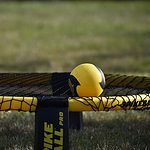When deciding between pickleball and tennis, you might wonder: Is pickleball truly easier than tennis?
The initial perception might lean towards pickleball's simplicity, but as you're about to discover, the comparison between these two racket sports goes beyond just the surface.
Are you ready to explore the nuances that might surprise you?
Key Takeaways
- Pickleball offers gentler physical demands and lower injury risk than tennis.
- Pickleball has a simpler learning curve, attracting beginners with its straightforward rules.
- Pickleball's slower pace and shorter rallies result in fewer unforced errors.
- Pickleball's smaller court size makes gameplay more manageable, especially for newcomers.
Pickleball Vs. Tennis: Physical Demands Comparison
Is pickleball less physically demanding compared to tennis due to differences in court size and gameplay intensity?
Pickleball, with its smaller courts and reduced running distances, is indeed considered to be gentler on the joints and muscles than tennis. The smaller court size in pickleball results in shorter rallies and less running around, which can decrease the physical demands placed on players.
In contrast, tennis involves more explosive movements, quick sprints, and powerful hitting, leading to higher physical strain on the body. The intensity of play in tennis requires players to cover more ground and engage in swift, dynamic movements, contributing to its higher physical demands compared to pickleball.
Therefore, individuals looking for a sport that's less strenuous on the body may find pickleball to be a more suitable option due to its smaller courts and less intense gameplay, which can help reduce the risk of joint and muscle injuries.
Pickleball Court Size Vs. Tennis Court Size
The significant contrast in size between pickleball courts, measuring 20 feet wide by 44 feet long, and tennis courts, which are 78 feet long, impacts the gameplay dynamics and movement requirements in each sport.
Here's how the smaller pickleball court size compares to a tennis court:
- Space Efficiency: Up to 4 pickleball courts can fit on the same surface area occupied by a single tennis court, allowing for more games to be played simultaneously.
- Movement Reduction: The reduced court size in pickleball means players have to cover less ground during a match compared to tennis, making it easier for beginners to navigate the court efficiently.
- Adaptation: Communities are repurposing tennis courts to accommodate multiple pickleball courts due to the smaller court size, reflecting the sport's growing popularity.
- Accessibility: The smaller court size in pickleball makes it more approachable for newcomers, as it requires less physical endurance and allows for quicker skill development.
The differences in court size between pickleball and tennis can significantly alter the playing experience and appeal to different skill levels.
Pickleball Vs. Tennis: Learning Curve
Comparing the learning curves of pickleball and tennis reveals distinct differences in initial skill acquisition and rule comprehension. Pickleball is often perceived as easier to learn initially due to its simpler rules compared to tennis. In pickleball, understanding the non-volley zone is crucial, unlike in tennis, which adds complexity to the game. The learning curve for pickleball may be smoother because of its more straightforward rules and gameplay.
However, tennis rules, especially serving and scoring, can be more intricate and challenging for beginners. To excel in pickleball, players need to grasp etiquette, serving rules, and gameplay nuances for competitive play. On the other hand, while tennis has a steeper learning curve, mastering its complexities can lead to a rich and rewarding experience on the court.
Understanding the differences in learning curves between pickleball and tennis can help individuals choose the sport that aligns best with their preferences and skill level.
Pickleball and Tennis: Pace Differences
Pickleball and tennis exhibit contrasting paces primarily due to the differences in court size and gameplay intensity.
- In pickleball, the smaller court size results in shorter rallies, reducing the amount of running required during a match.
- The physically demanding nature of tennis is evident in the longer rallies and intense movements, necessitating higher levels of endurance and agility.
- Pickleball's reduced court size allows for a slower pace, giving players more time to react and strategize their shots.
- The pace difference between pickleball and tennis caters to different preferences in gameplay speed, offering options for players who may enjoy varying levels of intensity.
Pickleball Vs. Tennis: Injury Risk Analysis
When considering injury risks between pickleball and tennis, the contrasting physical demands and gameplay intensities play a significant role. Pickleball is generally less intense than tennis, making injuries less likely in pickleball due to its slower pace and smaller court size.
In tennis, players often overstretch their reach, leading to muscle strains and ligament injuries. Pickleball's easier gameplay and less distance to cover reduce the likelihood of severe injuries compared to the more physically demanding nature of tennis.
While pickleball injuries like sprained ankles and shin splints are common, they're usually less severe than the tendinitis and muscle strains frequently seen in tennis players. Both sports require proper technique and conditioning to prevent injuries, but pickleball's consistent pace and fewer sudden movements make it easier on the body, lowering the overall risk of getting hurt during play.
Pickleball Vs. Tennis: Rules and Scoring
Understanding the rules and scoring systems of pickleball and tennis is essential for players to navigate the unique aspects of each sport effectively. Here are some key differences between the rules and scoring of pickleball and tennis:
- Serving: In pickleball, serves must be underhand, making it easier for beginners compared to the overhand serves in tennis.
- Scoring: Tennis scoring involves games, sets, and tiebreakers, while pickleball scoring is based on a point margin to win, simplifying the scoring system.
- Non-Volley Zone: Pickleball has a non-volley zone near the net that restricts players from hitting volleys in that area, adding a strategic element to the game.
- Two-Bounce Rule: The two-bounce rule in pickleball allows the receiving side more time to react since they can let the ball bounce once before returning, enhancing the game's accessibility.
Understanding these rules and scoring nuances is vital for players looking to excel in either pickleball or tennis, as each sport presents its own challenges and strategies.
Pickleball Vs. Tennis: Equipment Variation
Comparing the equipment used in pickleball and tennis reveals significant differences in weight, materials, and cost. In pickleball, players use a paddle and a plastic ball, while tennis players wield a heavier racket and a bouncier ball.
The lighter pickleball paddle and plastic ball make handling and control easier, especially for beginners or those looking for a more accessible sport. On the other hand, tennis gear tends to be pricier than pickleball equipment, making pickleball a more cost-effective option for those looking to start playing.
The equipment variances also impact gameplay and shot execution, with pickleball emphasizing simplicity and ease of play. These differences contribute to the unique playing styles and strategies in each sport, as players adapt to the specific equipment requirements of pickleball on smaller courts with plastic balls, while tennis is played on larger courts with traditional tennis balls, both following similar principles but with distinct equipment preferences.
Pickleball Vs. Tennis: Gameplay Variances
Pickleball and tennis exhibit notable differences in gameplay mechanics that impact strategy and player dynamics. When comparing pickleball vs tennis, shot placement plays a crucial role. In pickleball, players often focus on precise shot placement rather than power due to the smaller court size, encouraging strategic play over brute force. Additionally, the need to take risks is more prevalent in tennis, where players must hit winners to score points, while pickleball allows for a more controlled approach.
- Pickleball courts are smaller, requiring players to cover less ground and making movement more manageable.
- The use of a pickleball paddle in pickleball differs from the tennis racket, affecting shot selection and control.
- Unforced errors are more common in tennis due to the faster-paced gameplay and the need for aggressive shots.
- Pickleball is generally easier to learn than tennis, making it more accessible to beginners looking to pick up a new sport.
Pickleball Vs. Tennis: Strategy Complexity
When exploring the strategy complexity between pickleball and tennis, an essential distinction arises in the level of tactical intricacy required by players in each sport. Tennis demands a higher level of strategic thinking due to its complex shot selection, tactical maneuvers, and overall gameplay elements. Players must master techniques like topspin, slice, and lobs to outmaneuver opponents effectively.
In contrast, pickleball focuses more on positioning, consistency, and smart shot selection rather than elaborate tactical plays. Pickleball games often revolve around capitalizing on opponent mistakes and minimizing unforced errors to secure a win, rather than intricate shot placement strategies common in tennis.
While both sports require strategy, tennis tends to involve a more intricate and varied approach to gameplay, making it more challenging in terms of strategic complexity. Players looking for a sport with deeper tactical depth may find tennis to be a more suitable choice compared to the relatively simpler strategic demands of pickleball.
Pickleball Vs. Tennis: Overall Accessibility
Accessibility to both pickleball and tennis varies significantly, with factors such as cost, court size, and physical demands playing a crucial role in determining the ease of participation in each sport. When comparing pickleball and tennis in terms of overall accessibility:
- Equipment Costs: Pickleball proves to be more financially accessible than tennis due to lower equipment costs.
- Court Size: Pickleball courts are smaller, requiring less running, which makes the sport more accessible to individuals of various ages and fitness levels.
- Ball Speed: The slower ball speed in pickleball compared to tennis contributes to its accessibility for beginners and older players.
- Social Atmosphere: Pickleball fosters a more social and inclusive atmosphere, encouraging players of all skill levels to participate.





